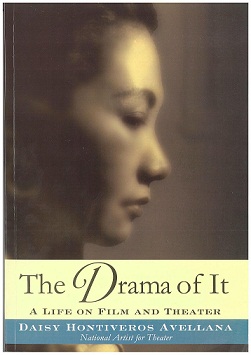BY PABLO A. TARIMAN
 THE First Lady of Philippine Theater, Daisy Hontiveros-Avellana, made her last true-to-life stage exit on a Mother’s Day, May 12.
THE First Lady of Philippine Theater, Daisy Hontiveros-Avellana, made her last true-to-life stage exit on a Mother’s Day, May 12.
She was 96.
Those who missed her prime as a stage actress should turn to her autobiography, “The Drama of It: A Life on Film and Theater.”
The book reveals she didn’t just act; she was also a short story writer and won prizes for it.
Fact is her autobiography reads like a fine short story: brief, concise but full of humor and so self-effacing you wonder if she was writing about somebody else other than herself.
The book blurb captures not just the actress but her true-to-life leading man, Lamberto V. Avellana who happens to be another National Artist for Theater and Film.
True enough, the book is indeed a front seat in the life-theater of the country’s theater icons.
In the first chapter entitled, “My Wedding Gown,” the bride admitted she and the groom didn’t share many things in common. For one, she was near-sighted and the husband was far-sighted. The daughter of a lawyer and a violinist, the young Hontiveros grew up on the banks of Panay River in Capiz. The son of a doctor, the groom was born and raised in Bontoc, Mountain Province.
 When they met in Manila during their college years, they discovered their common passion: theater. She was acting in UP theater production; he was in the Ateneo dramatic guild.
When they met in Manila during their college years, they discovered their common passion: theater. She was acting in UP theater production; he was in the Ateneo dramatic guild.
After marriage, they were also collaborative partners in film projects (“Sakay” and the film version of Nick Joaquin’s “Portrait of the Filipino as an Artist”) and in more theater endeavors before, during and after the war.
In between theater opening nights are true-to-life scenes from the couple’s offstage life: death in the family, life during the war, coping with meager income as performing artists. To the very end of their lives, they didn’t compromise their art. They’d rather starve than do films from the “bakbakan-sampalan-sabunutan” school of acting, a reference to Tagalog films full of fight scenes, histrionics and violent domestic confrontations.
Director Lamberto Avellana noted that his “Anak Dalita” won the highest cinematic honors in Southeast Asia and his “Badjao” won major honors in Hong Kong. Their film version of Nick Joaquin’s “Portrait…” received unanimous acclaim but suffered the same fate: they all died on the way to the box office.
What Ms. Avellana considered an ultimate reward was the comment of American stage actress Helen Hayes on the film version of “Portrait…” Hayes saw the film as part of the 1966 cultural mission tour of the Far East sponsored by the State Department.
 The National Artist recalled: “When we came up to meet her (Hayes), she was generous with her compliments. To Bert (Avellana), she said, ‘It would have been a privilege for me in my younger days to act in such a role and with such a cast… it would have been an honor to be directed by you!’ And to me she said: ‘The light scene…I could feel every moment with you and I anticipated the exact moment when you broke into weeping after the hysterical laughter.’”
The National Artist recalled: “When we came up to meet her (Hayes), she was generous with her compliments. To Bert (Avellana), she said, ‘It would have been a privilege for me in my younger days to act in such a role and with such a cast… it would have been an honor to be directed by you!’ And to me she said: ‘The light scene…I could feel every moment with you and I anticipated the exact moment when you broke into weeping after the hysterical laughter.’”
That was not the only tribute that Hayes gave her. “A few days later, when I was introduced to her once again at a formal function, she said:’ In your country Daisy, it is I who should stand to you.’ I was deeply moved. I might add that the first time I received payment for my acting was for the film ‘Portrait’ in 1965! Before this, it was all gratis and plenty of amore. But it was all worth it,” Daisy said.
Carmen Guerrero Nakpil wrote in the book’s introduction: “When reading the typescript for the first time, I came to the end of The Drama Of It by Daisy Hontiveros Avellana… I burst into tears. In a rush of emotion, it all came back to me. It is one big, great tale not only about the Avellanas, but also about how life used to be lived in this country, about art and theater. About dedication to ideals and unfailing courage and untainted ambitions and, above all, undying, generous,, magnificent love. This is a splendid memoir that I wish I had written myself.”
The National Artist for Theater will be given a state funeral Friday, May 17 after the 9 a.m. necrological service at the Cultural Center of the Philippines.
